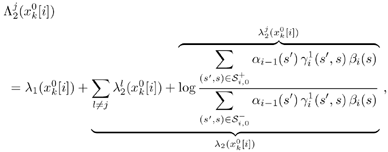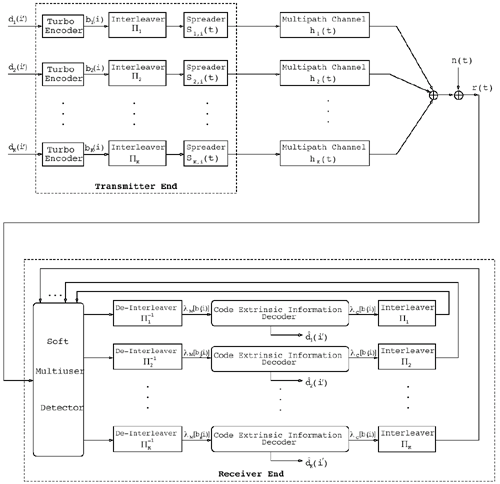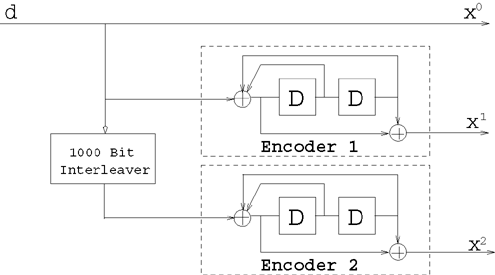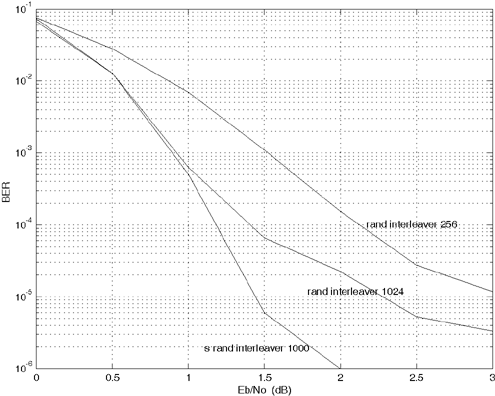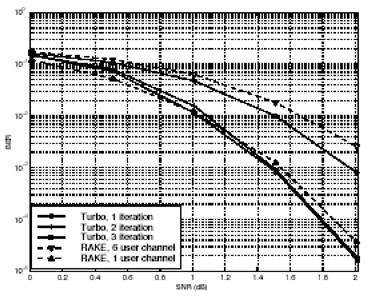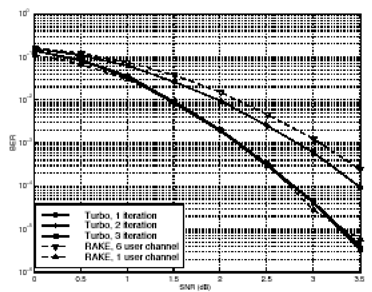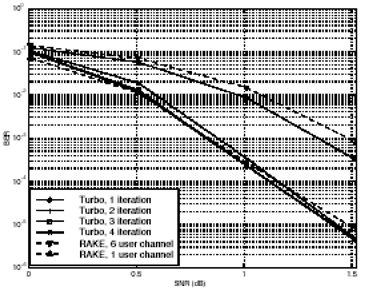6.6 Turbo Multiuser Detection in CDMA with Turbo Coding
| In this section we discuss turbo multiuser detection for CDMA systems employing turbo codes. Parallel concatenated codes, called turbo codes , constitute the most important breakthrough in coding of the 1990s [177]. Since these powerful codes can achieve near-Shannon-limit error correction performance with relatively low complexity, they have been adopted as an optional coding technique standardized in third-generation (3G) CDMA systems [201]. We first give a brief introduction to turbo codes and describe the turbo decoding algorithm for computing the extrinsic information. We then compare the performance of a turbo multiuser receiver with that of a conventional RAKE receiver followed by turbo decoding, in a turbo-coded CDMA system with mulitpath fading channels. The material discussed in this section was developed in [256, 257]. 6.6.1 Turbo Code and Soft Decoding AlgorithmTurbo EncoderA typical parallel concatenated convolutional (PCC) turbo encoder consists of two (or more) simple constituent recursive convolutional encoders linked by an interleaver (or different interleavers). A block diagram of such an encoder is shown in Fig. 6.13. The interleavers can be random, nonrandom, or semirandom. Figure 6.13. Typical turbo encoder. The turbo encoder works as follows . Suppose that all constituent encoders start from the zero state and the first constituent encoder terminates in the zero state. For user k , the frame of input binary information bits, denoted by d k = [ d k [0], ..., d k [ I “ 1], is encoded by the constituent encoders, where I is the size of the information bit frame. Let x k [ i ] = [ Soft Turbo Decoder Corresponding to the turbo encoder in Fig. 6.13, the block diagram of an iterative soft turbo decoder is shown in Fig. 6.14. The turbo decoder consists of J MAP decoders. Each MAP decoder is a slight modification of the MAP decoding algorithm for multiple turbo codes given in [29, 100]. The signal flow is shown in Fig. 6.14. The deinterleaved LLRs { l 1 ( b k [ i ])} i of the k th user's code bits delivered by the SISO multiuser detector are distributed to the J MAP decoders as follows. The LLRs of the systematic bits, { l 1 ( Figure 6.14. Soft turbo decoder. The soft turbo decoder is itself an iterative algorithm. The j th MAP decoder in the turbo decoder computes the partial extrinsic information for the systematic bit and the j th parity bit, Denote the LLR of a code bit at the j th MAP decoder as Equation 6.169 where Equation 6.170 as the partial extrinsic information of bit As before, a i ( s ) and b i -1 ( s ) can be computed by the following forward and backward recursions, respectively: Equation 6.171 Equation 6.172 where S is the set of all 2 n constituent encoder states. The quantity g i is defined as Equation 6.173 Note that, by definition, Equation 6.174 Then for b Equation 6.175 Equation 6.176 Equation 6.177 where (6.176) follows from the fact that b Equation 6.178 Substituting (6.178) into (6.169), we have Equation 6.179 Equation 6.180 where the term Equation 6.181 For numerical stability, (6.179) and (6.180) should be scaled as computation proceeds, in a manner similar to that discussed in Section 6.3.3. 6.6.2 Turbo Multiuser Receiver in Turbo-Coded CDMA with Multipath FadingIn this section we demonstrate the performance of the turbo multiuser receiver in a turbo-coded CDMA system with multipath fading. We consider a K -user CDMA system employing random aperiodic spreading waveforms and signaling through multipath fading channels. Each user's information data bits are encoded by a turbo encoder and then randomly interleaved. The interleaved code bits are then BPSK mapped and spread by a random signature waveform before being sent to the multipath fading channel. A block diagram of the system is illustrated in Fig. 6.15. The turbo multiuser receiver for this system iterates between the SISO multiuser detection stage (as discussed in Section 6.5.2) and the soft turbo decoding stage (as discussed in Section 6.6.1) by passing the extrinsic information of the code bits between the two stages. Figure 6.15. Turbo-coded CDMA system with a turbo multiuser receiver. Single-User RAKE ReceiverTo compare the performance of a turbo multiuser receiver with that of a conventional technique used in practical systems, a single-user RAKE receiver employing maximal-ratio combining followed by a turbo decoder for the turbo-coded CDMA system is described next. The received signal in this system is given by (6.133) and (6.134). In a single-user RAKE receiver, the decision statistic for the k th user's i th code bit, b k [ i ], is given by y k [ i ] defined in (6.138): Equation 6.182 To obtain the LLR of the code bit b k [ i ] based on y k [ i ], a Gaussian assumption is made on the distribution of y k [ i ]. Moreover, assume that the user spreading waveforms contain i.i.d. random chips and that the time delay t l,k is distributed uniformly over a symbol interval. Assume also that the multipath fading gains are independent between different users and are normalized such that Equation 6.183 The LLRs { l 1 ( b k [ i ])} i of the k th user's code bits are then sent to the corresponding turbo decoder to obtain the estimated information bits. Note that the SISO multiuser detector discussed in Section 6.5.2 operates on the same decision statistic as the conventional RAKE receiver (i.e., the outputs of the maximum ratio combiners { y k [ i ]} k;i ). The RAKE receiver demodulates the k th user's data bits based only on { y k [ i ]} i , whereas the SISO multiuser detector demodulates all users' data bits jointly using all decision statistics { y k [ i ]} i;k . Simulation ExamplesNext we demonstrate the performance of the proposed turbo multiuser receiver in multipath fading CDMA channels by some simulation examples. The multipath channel model is given by (6.132). The number of paths for each user is three ( L = 3). The delays of all users' paths are randomly generated. The time-varying fading coefficients are randomly generated to simulate channels with different data rates and vehicle speeds. The parameters are chosen based on the prospective services of wideband CDMA systems [431]. We consider a reverse link of an asynchronous CDMA system with six users ( K = 6). The spreading sequence of each different user's different coded bit is independently and randomly generated. The processing gain is N = 16. Each user uses a different random interleaver to permute its code bits. In all simulations, the same set of interleavers is used, and all users have equal signal amplitudes. The number of iterations within each soft turbo decoder is five. The code we choose is a rate-1/3 binary turbo code, whose encoder is shown in Fig. 6.16. The two recursive convolutional constituent encoders have a generator polynomial, with effective free distance 10 [30]. An S-random interleaver, p j , shown in Fig. 6.14, is used and explained below. The interleaver size is I = 1000 and S = 22. (Hence the symbol frame length M = 3000.) Figure 6.16. Rate-1/3 turbo encoder. The S-random interleaver [103] is one type of semirandom interleaver. It is constructed as follows. To obtain a new interleaver index, a number is randomly selected from the numbers that have not previously been selected as interleaver indices. The number selected is accepted if and only if the absolute values of the differences between the number currently selected and the S numbers accepted previously are greater than S . If the number selected is rejected, a new number is selected randomly. This process is repeated until all I (interleaver size) indices are obtained. The searching time increases with S . Choosing S < Example 1: Effect of the S-Interleaver The BER performance of the turbo code used in this study with random interleavers and an S-random interleaver in a single-user AWGN channel is plotted in Fig. 6.17. It is seen that the S-random interleaver offers a significant interleaver gain over random interleavers. Figure 6.17. BER performance of the turbo code with different interleavers. (Random interleavers with size 256 and 1024, S-random interleaver with size 1000.) In the following three examples, the performance of a turbo multiuser receiver is compared with that of a conventional single-user RAKE receiver. The single-user RAKE receiver computes the code-bit LLRs of the K th user using (6.183); these are then fed to a turbo decoder to decode the information bits. The BER averaged over all six users is plotted. Example 2: Fast Vehicle Speed and Low Data Rate In this example we consider a Rayleigh fading channel with vehicle speed of 120 km/h, data rate of 9.6 kb/s, and carrier frequency of 2.0 GHz (the effective bandwidth “time product is BT = 0.0231). The results are plotted in Fig. 6.18. Figure 6.18. BER performance comparison between a turbo multiuser receiver and a RAKE receiver in a multipath fading channel with K = 6, processing gain N = 16, vehicle speed 120 km/h, data rate 9.6 kb/s, and carrier frequency 2.0 GHz. Example 3: Medium Vehicle Speed and Medium Data Rate Next, we consider a multipath Rayleigh fading channel with vehicle speed 60 km/h, data rate 38.4 kb/s, and carrier frequency 2.0 GHz ( BT = 0.00289). The results are plotted in Fig. 6.19. Figure 6.19. BER performance comparison between a turbo multiuser receiver and a RAKE receiver in a multipath fading channel with K = 6, processing gain N = 16, vehicle speed 60 km/h, data rate 38.4 kb/s, and carrier frequency 2.0 GHz. Example 4: Very Slow Fading Finally, we consider a very slow fading channel (a time-invariant channel). The fading coefficients { a l,k } of paths are randomly generated and kept fixed, and every user has equal received signal energy. The results are plotted in Fig. 6.20. Figure 6.20. BER performance comparison between a turbo multiuser receiver and a RAKE receiver in a time-invariant multipath channel with K = 6 and processing gain N = 16. From Examples 2, 3, and 4 it is seen that significant performance gain is achieved by a turbo multiuser receiver compared with a conventional noniterative receiver (i.e., the RAKE receiver followed by a turbo decoder). The performance of a turbo multiuser receiver with two iterations is very close to that of a RAKE receiver in a single-user channel. Moreover, at high SNR, the detrimental effects of multiple-access and intersymbol interference in the channel can be eliminated almost completely. Furthermore, it is seen from the simulation results that a turbo multiuser receiver in a multiuser channel even outperforms a RAKE receiver in a single-user channel. This is because the RAKE receiver makes the assumption that the delayed signals from different paths for each user are orthogonal, which effectively neglects the intersymbol interference. |
EAN: 2147483647
Pages: 91
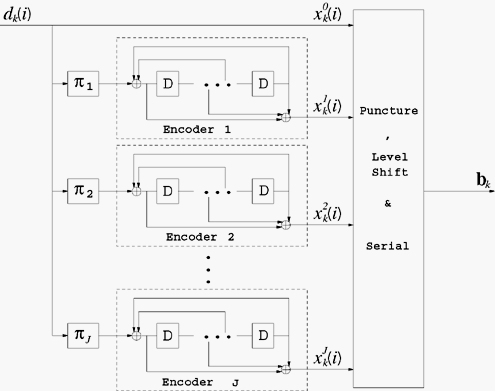
 0, is the parity bit generated by the
0, is the parity bit generated by the 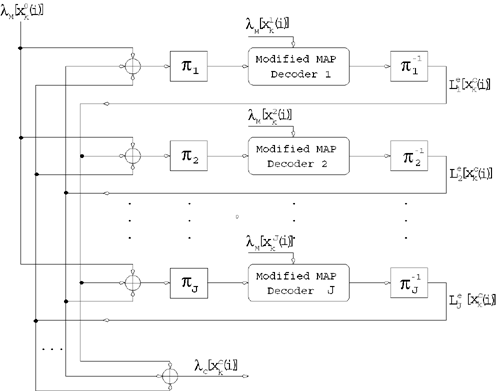


 {+1, “1}, we have
{+1, “1}, we have 

